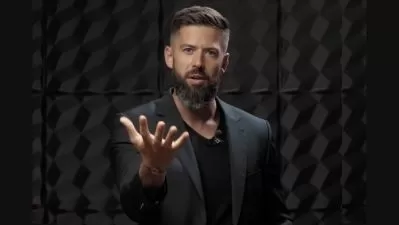Leadership: Guide to Body Language & Nonverbal Communication
Robin Hills
1:38:49
Description
A Comprehensive Guide to Mastering Body Language and Nonverbal Communication for Effective Leadership in Business
What You'll Learn?
- Define body language and its significance in communication.
- Describe the connection between emotions and their corresponding nonverbal signals.
- Identify key components of nonverbal cues: gestures, facial expressions, posture.
- Interpret the body language of others to determine their underlying emotions and emotional states.
- Analyse body language cues in a wide variety of professional situations.
- Demonstrate techniques for working with and displaying confident body language in various scenarios.
Who is this for?
What You Need to Know?
More details
DescriptionWhy can some people communicate better than others?
Very simply, effective communicators know how to interpret their own and other people’s non-verbal cues. In other words, they understand body language, physical gestures, voice tones and facial expressions.
Body language is the unspoken or non-verbal mode of communication that we perform in every aspect of our interaction with others. It affects us all on a daily basis. Everything we do, from walking, talking, sitting, standing, gestures and mannerisms define how successful we are.
Body language is often underused in the world of business and when put into practice, the results can be extremely beneficial. The language that we give out to others can be varied and inconsistent and we may not be consciously aware of how we come across to others.
Have you ever felt that you were just not communication effectively as someone else in a conversation?
Have you ever lost a sales opportunity and couldn’t work out why?
Have you ever been in a situation when you really didn’t believe what someone was saying?
Did you have an intuitive sense that something was not right?
Then this leadership course on body language and nonverbal communication is for you!
Most people are unaware that much of communication is non-verbal and often conveys expressions of underlying emotion. Whenever people speak, their brains send information to different parts of their body to support the display of the messages they are trying to communicate. By observing and understanding these gestures, postures, facial expressions or even eye movements, you can easily recognise what someone is thinking and feeling and their intentions.Â
Understanding and working with body language and nonverbal cues is essential for growing and developing a person's emotional intelligence. It enhances empathy, builds rapport, establishes trust, fosters heightened social awareness, and maintains positive relationships.
Leaders who comprehend body language are able to determine the morale, engagement, and concerns of their people and their team.  Adjusting their approach based on these cues, leaders can inspire, motivate, and lead more effectively by aligning their verbal and nonverbal expressions, to enable them to communicate more authentically and build congruence.
This course, Leadership: Guide to Body Language & Nonverbal Communication, is focused on the intricate world of body language and nonverbal communication, where gestures, postures, and expressions speak volumes.Â
Within this body language course, you’ll discover how unspoken cues convey emotions, intentions, and thoughts, often louder than words themselves.
The course will give you all the tools you need to interact with customers, clients, colleagues, managers and other leaders in the modern workplace.
Exploring specific work situations, you'll gain insight into interpreting both your own and others' body language, enhancing your interpersonal skills to come across with more credibility and confidence and lead more effectively.  The course will give you a complete understanding of how to act appropriately and respond accordingly in conversations involving sales and selling, negotiation, interviewing and coaching and mentoring.
By completing this course, you will be able to
Define body language and its significance in communication.
Describe the connection between emotions and their corresponding nonverbal signals.
Identify key components of nonverbal cues: gestures, facial expressions, posture.
Interpret the body language of others to determine their underlying emotions and emotional states.
Analyse body language cues in a wide variety of professional situations
Demonstrate techniques for working with and displaying confident body language in various scenarios.
Prepare to build rapport and uncover hidden meanings through these essential body language insights. Elevate your leadership to new heights by mastering the art of effective communication beyond speech.Â
PLEASE NOTE - This course is NOT for you if you are not prepared to work through the practical activities that make up a fundamental part of the course. Understanding body language and nonverbal communication cannot be developed just by watching the video lectures. It requires you to do some reflective thinking, to get some feedback and to discuss your development with others. I'm afraid that you won't get the best from the course unless you are prepared to do this.
Embark on this enlightening journey, and unlock the secrets behind the silent language that shapes our interactions every day.
All videos are High Definition recorded in 1080p.
All PDFs can be completed online and are Section 508 / ADA Accessibility compliant.
All videos have grammatically correct English captions.
Latest update - September 2023
Learning Outcomes
Define body language and its significance in communication.
Describe the connection between emotions and their corresponding nonverbal signals.
Identify key components of nonverbal cues: gestures, facial expressions, posture.
Interpret the body language of others to determine their underlying emotions and emotional states.
Analyse body language cues in a wide variety of professional situations
Demonstrate techniques for working with and displaying confident body language in various scenarios.
Who this course is for:
This course is for anyone who wants to enhance their leadership capabilities focusing on working with body language and nonverbal communication in a variety of work settings.
Anyone who wants to learn how to communicate more effectively with others and build strong, healthy relationships.
Who this course is for:
- This communication skills course is designed for anyone in a leadership position in an organisation who is interested in improving the emotional climate
- You will be responsible for leading and managing groups of people to achieve outcomes and enhance performance.
- This course will not be of interest to you if you manage processes and tasks with little focus on the people involved.
Why can some people communicate better than others?
Very simply, effective communicators know how to interpret their own and other people’s non-verbal cues. In other words, they understand body language, physical gestures, voice tones and facial expressions.
Body language is the unspoken or non-verbal mode of communication that we perform in every aspect of our interaction with others. It affects us all on a daily basis. Everything we do, from walking, talking, sitting, standing, gestures and mannerisms define how successful we are.
Body language is often underused in the world of business and when put into practice, the results can be extremely beneficial. The language that we give out to others can be varied and inconsistent and we may not be consciously aware of how we come across to others.
Have you ever felt that you were just not communication effectively as someone else in a conversation?
Have you ever lost a sales opportunity and couldn’t work out why?
Have you ever been in a situation when you really didn’t believe what someone was saying?
Did you have an intuitive sense that something was not right?
Then this leadership course on body language and nonverbal communication is for you!
Most people are unaware that much of communication is non-verbal and often conveys expressions of underlying emotion. Whenever people speak, their brains send information to different parts of their body to support the display of the messages they are trying to communicate. By observing and understanding these gestures, postures, facial expressions or even eye movements, you can easily recognise what someone is thinking and feeling and their intentions.Â
Understanding and working with body language and nonverbal cues is essential for growing and developing a person's emotional intelligence. It enhances empathy, builds rapport, establishes trust, fosters heightened social awareness, and maintains positive relationships.
Leaders who comprehend body language are able to determine the morale, engagement, and concerns of their people and their team.  Adjusting their approach based on these cues, leaders can inspire, motivate, and lead more effectively by aligning their verbal and nonverbal expressions, to enable them to communicate more authentically and build congruence.
This course, Leadership: Guide to Body Language & Nonverbal Communication, is focused on the intricate world of body language and nonverbal communication, where gestures, postures, and expressions speak volumes.Â
Within this body language course, you’ll discover how unspoken cues convey emotions, intentions, and thoughts, often louder than words themselves.
The course will give you all the tools you need to interact with customers, clients, colleagues, managers and other leaders in the modern workplace.
Exploring specific work situations, you'll gain insight into interpreting both your own and others' body language, enhancing your interpersonal skills to come across with more credibility and confidence and lead more effectively.  The course will give you a complete understanding of how to act appropriately and respond accordingly in conversations involving sales and selling, negotiation, interviewing and coaching and mentoring.
By completing this course, you will be able to
Define body language and its significance in communication.
Describe the connection between emotions and their corresponding nonverbal signals.
Identify key components of nonverbal cues: gestures, facial expressions, posture.
Interpret the body language of others to determine their underlying emotions and emotional states.
Analyse body language cues in a wide variety of professional situations
Demonstrate techniques for working with and displaying confident body language in various scenarios.
Prepare to build rapport and uncover hidden meanings through these essential body language insights. Elevate your leadership to new heights by mastering the art of effective communication beyond speech.Â
PLEASE NOTE - This course is NOT for you if you are not prepared to work through the practical activities that make up a fundamental part of the course. Understanding body language and nonverbal communication cannot be developed just by watching the video lectures. It requires you to do some reflective thinking, to get some feedback and to discuss your development with others. I'm afraid that you won't get the best from the course unless you are prepared to do this.
Embark on this enlightening journey, and unlock the secrets behind the silent language that shapes our interactions every day.
All videos are High Definition recorded in 1080p.
All PDFs can be completed online and are Section 508 / ADA Accessibility compliant.
All videos have grammatically correct English captions.
Latest update - September 2023
Learning Outcomes
Define body language and its significance in communication.
Describe the connection between emotions and their corresponding nonverbal signals.
Identify key components of nonverbal cues: gestures, facial expressions, posture.
Interpret the body language of others to determine their underlying emotions and emotional states.
Analyse body language cues in a wide variety of professional situations
Demonstrate techniques for working with and displaying confident body language in various scenarios.
Who this course is for:
This course is for anyone who wants to enhance their leadership capabilities focusing on working with body language and nonverbal communication in a variety of work settings.
Anyone who wants to learn how to communicate more effectively with others and build strong, healthy relationships.
Who this course is for:
- This communication skills course is designed for anyone in a leadership position in an organisation who is interested in improving the emotional climate
- You will be responsible for leading and managing groups of people to achieve outcomes and enhance performance.
- This course will not be of interest to you if you manage processes and tasks with little focus on the people involved.
User Reviews
Rating
Robin Hills
Instructor's Courses
Udemy
View courses Udemy- language english
- Training sessions 39
- duration 1:38:49
- Release Date 2023/10/17











